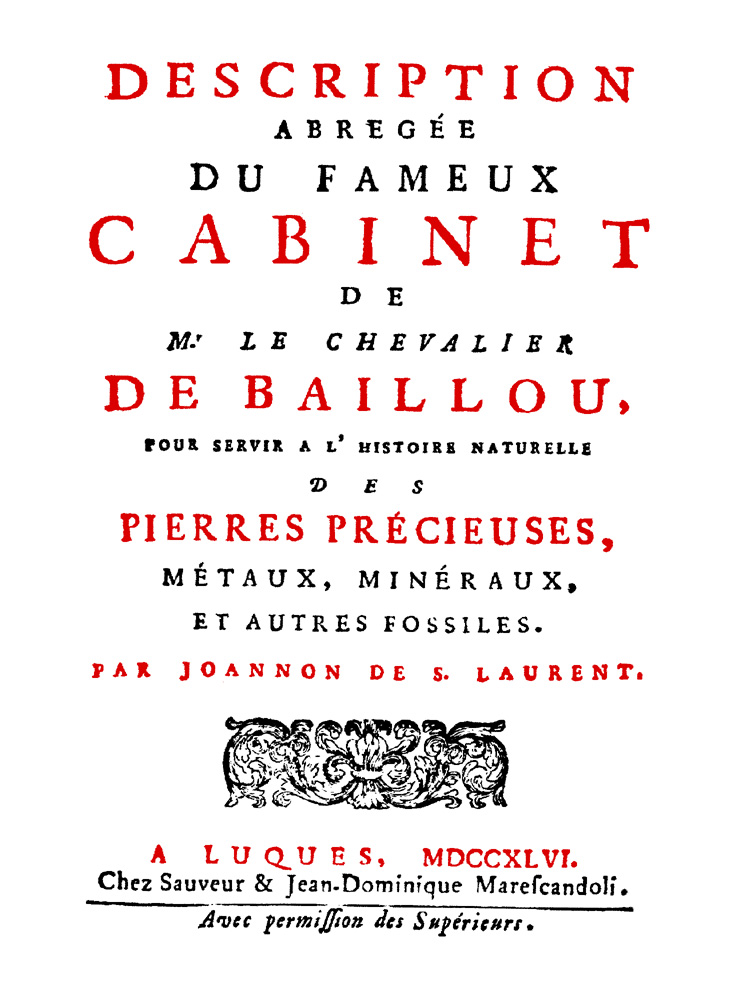SAINT-LAURENT, Joannon de.
(1710? – ?)

1. Latin, 1746 [Collection catalog].
[In red:] Description | [in black:] Abregée | Du Fameux | [in red:] Cabinet | [in black:] De | M.r Le Chevalier | [in red:] De Baillou, | [in black:] Pour Servir A L'Histoire Naturelle | Des | [in red:] Pierres Precieuses, | [in black:] Métaux, Minéraux, | Et Autres Fossiles. | [in red:] Par Joannon De St. Laurent. | [ornament] | [in red:] A Luques, MDCCXLVI. | [in black:] Chez Sauveur & Jean-Dominique Marescandoli. | [rule] | Avec premission des Supérieurs.
4°: π1 [Cross]4 A-T4 V2; 83l.; [2], I-VIII, 1-156 p., one plate (p. 149; in red and black). Title in red and black. Printer's device, page 155. Page size: 220 x 160 mm.
Contents: [2 pgs], Title pages, verso blank.; I-VIII, "Epitre."-dedication, signed Joannon De Saint-Laurent.; 1-155, Text.; 156, "Table | Des Chapitres."
Very rare. Sole edition of this remarkable 1746 prospectus that describes only a small portion of the extensive mineralogical cabinet of the Florentine naturalist Johann De Baillou [see note below]. At the time, the complete collection comprised 30,000 samples of minerals, fossils, rocks and shells, and was one of the largest in the world. This volume provides details of Baillou's collecting philosophy and descriptions of some of the finest specimens of precious stones, native metals, minerals, crystals and other fossils contained in the collection. Baillou vainly hoped that the publication of this small volume would help obtain support for a much more ambitious catalog of his collection; however, its only effect was that it influenced Emperor Franz Stefan I into purchasing the collection in 1748 and retaining De Baillou as its curator, when the whole was moved to Vienna. Upon the Emperor's death in 1765, the Empress Maria Theresa presented the collection to the state and opened it to public viewing. The remnants of it are preserved today in the Naturhistorisches Museum in Vienna.
The volume opens with a preliminary discourse, followed by 27 chapters. Topics include a general idea of the cabinet, the philosophy behind collecting natural history specimens, the principles of the cabinet and petrifications. Other chapters describe the metals, precious stones, marine fossils, corals, crustaceans, animal fossils, earths, salts, sulfurs, alabaster & marble, jaspers of various types, agates & cornealians, pyrites, semi-metals, and rock crystal. The last chapter provides a general description of the cabinet's organization.
Facing page 149 is a plate printed in red and black, showing the title page of a proposed and never published work. It was Baillou's wish to prepare a full descriptive catalog of the collection, utilizing his own system of classification. It would appear in seven folio size volumes, printed on imperial paper and illustrated by 600 plates rendering the finest specimens. It was a grandiose plan, and without the backing of a wealthy patron, impossible to complete. Unfortunately, the publication never went further than this preliminary solicitation for funds. The title as printed on the plate reads: [In red:] Traité Universel | [in black:] Des | [in red:] Pierres Précieuses, | [in black:] Métaux, Minéraux, | Et Autres Fossiles, | [in red:] Le Tout Distribué Dans Ses Propres Classes, | [in black:] Où l' on trouve leurs diférens noms, leurs origines, | leurs analises, leurs principes, leurs qualités, | leurs étimologies, leurs choix, | & tout ce qu' il y a de particulier | & remarquable en les exposant | au soïer de la Lentille astronomique | & du Miroir ardent. | On Y Traite Aussi | [in red:] Des Plantes Marines Pierreuses, | [in black:] Crustacés Et Coquillages De Mer, | Soit dans leur état naturel, soit en diférens dégrés | de Calcination & de pétrification. | [in red:] On Donne A La Fin | [in black:] Lat maniere de travailler toutes sortes de pierres, | & celle de les imiter par les voies les plus courtes | & dans leur plus grande perfection. | [in red:] Par M. Le Chevalier De Baillou.
Johann de Baillou. (Born: 1679; Died: Vienna, Austria, 1758) Italian naturalist. Baillou built an extensive natual history collection including 30,000 specimens of minerals, rocks and shells, which was among the world's largest. It was puchased in 1748 by the Emperor Fanz Stefan I, who transported the collection to Vienna and retained Baillou as its curator. After the Emperor's death in 1765, the Empress Maria Theres presented the collection to the state and opened it to the public. Today, it is incorporated into the Naturhistorisches Museum in Vienna.
Bibliographical references: Gatterer, Mineralogischen Literatur, 1798-9: 1, 271. • Laissus, Cabinets d'Histoire Naturelle, 1964. • LKG: XV 13. • NUC [no copy listed]. • Partsch, Katalog der Bibliothek, 1851: no. 470. • Sinkankas, Gemology Bibliography, 1993: no. 3230. • Wilson, History of Mineral Collecting, 1994: 101, 124 & 159.. (Baillou) DBA: I 50, 279-288. • WBI. • Wilson, History of Mineral Collecting, 1994: 159. • Wurzbach, Biographisches Lexikon Österreich, 1856-91.
.